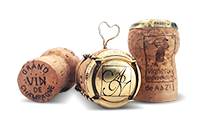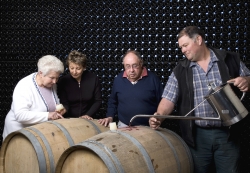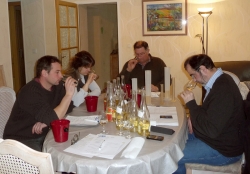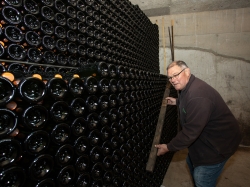Winemaking in Champagne
Crafting Champagne is a subtle art, born from know-how passed down through generations. Behind every bottle lies a long, intricate process, blending technical precision, intuition, and patience.
From the fermentation of the juice to the blending of cuvées, through the second fermentation in the bottle and aging on the lees, each step plays a vital role in creating this exceptional wine. We invite you to discover this demanding, meticulous, and fascinating journey.
Once the juice has been extracted from the grapes, it is transferred into stainless steel tanks or oak barrels to begin the first alcoholic fermentation. Under the action of yeasts, the sugar naturally transforms into alcohol over a period of two to three weeks.
After this fermentation, the wine is left to rest for several months. It then becomes what is known as a "vin clair", a still wine, without bubbles, already revealing its first aromatic expressions.
Blending the Cuvées
The true artistry of Champagne begins here. Unlike most wines, Champagne is the result of blending still wines from different years, vineyard plots, or grape varieties. This unique savoir-faire ensures a consistent style year after year, despite climatic variations.
Each Champagne house blends its cuvées like a chef crafting a recipe—with precision, intuition, and experience. The goal is to achieve a perfect balance of freshness, structure, and complexity.
When a harvest is exceptional, a cuvée may be made solely from that year's grapes. This is known as a vintage Champagne, whose personality faithfully reflects the character of the vintage.
Bottling and Second Fermentation (Prise de Mousse)
Once the blending is complete, the wine is bottled with the addition of a "liqueur de tirage", a mixture of sugar and selected yeasts. This triggers a second fermentation that takes place inside the bottle.
It is during this phase that carbon dioxide forms and becomes trapped in the bottle, creating Champagne’s iconic sparkle. This delicate stage is known as the "prise de mousse".
This fermentation must occur slowly and at a constant temperature to ensure the finesse of the bubbles and allow the most subtle aromas to develop.
Ageing on Lees
Once the second fermentation is complete, the bottles are laid to rest on their lees—dead yeast cells left over from fermentation—in chalk cellars.
Ageing on lees is a crucial step. It allows the wine to develop greater complexity, texture, and aromatic richness.
The minimum ageing period is one year for non-vintage Champagnes and three years for vintage cuvées, but many houses choose to extend this period well beyond to achieve even more refined aromas.
Throughout this step, the bottles are stored lying on their sides, stacked on wooden laths, in the cool, dark stillness of the cellars.









